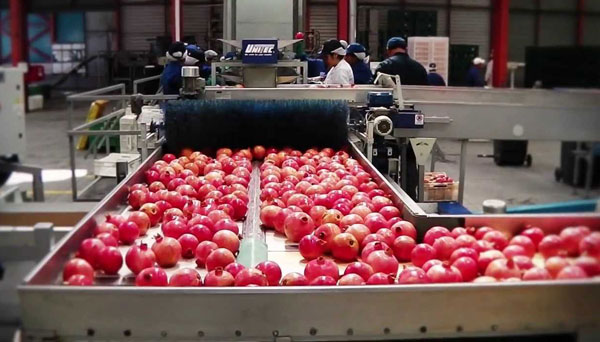Project Report For Pomegranate Processing
Introduction
Project Report For Pomegranate Processing is as follows.
The numerous procedures and techniques involved in transforming fresh pomegranates into value-added goods are referred to as pomegranate processing. Pomegranates are a popular fruit all over the world due to its brilliant red colour, juicy arils (seeds), and high nutritious value.
Pomegranates are processed not only to increase their shelf life, but also to generate a variety of products that may be consumed or used in a variety of sectors. The selection of ripe and healthy fruits is the first stage in pomegranate processing. After that, the fruits are cleaned to eliminate any dirt or contaminants. Pomegranates can be processed in a variety of ways after washing, depending on the intended final result.
Juicing is a frequent way of pomegranate preparation. The fruits are usually pressed to extract the juice, which can be eaten on its own or used as a component in smoothies, cocktails, or other culinary concoctions. Pomegranate juice is high in antioxidants and is becoming popular due to its possible health benefits.
The arils themselves are another famous pomegranate product. Arils can be manually taken from the fruit or harvested mechanically. These arils can be eaten as a fresh fruit snack, mixed into salads, or added to desserts, yoghurt, and other culinary preparations.
Pomegranate processing also includes the creation of pomegranate concentrate. The juice is extracted first, and then the water content is lowered using evaporation or other concentration procedures. Pomegranate concentrate has a strong flavour and may be used as a natural sweetener or flavouring ingredient in food and beverage items.
Pomegranate processing can result in pomegranate molasses, pomegranate powder, and pomegranate extracts in addition to juice and arils. Because of their distinct flavour profiles and possible health advantages, these items are used in the culinary, pharmaceutical, and cosmetic sectors.

Uses Of Pomegranate Processing
Food and Beverage Industry: Pomegranate processing produces a variety of products for the food and beverage industries. Pomegranate juice, arils, and concentrates are used in smoothies, cocktails, desserts, sauces, and dressings. Pomegranate molasses offers a tart and sweet flavour to foods, whilst pomegranate powder is used as a natural food colouring or flavour enhancer.
Pharmaceutical Industry: Pomegranate extracts are well-known for their possible health benefits. They include antioxidants, polyphenols, and other bioactive chemicals that have been researched for their anti-inflammatory, antibacterial, and anticancer activities. Pomegranate extracts are utilised in the creation of nutritional supplements, natural treatments, and pharmaceutical formulations.
Cosmetics & Personal Care: The cosmetics industry values pomegranate for its skin-enhancing benefits. Pomegranate extracts and oils are included in a variety of skincare products, including creams, lotions, serums, and masks. They are said to provide moisturising, anti-aging, and skin-protective properties.
Nutraceuticals: Nutraceuticals are made from pomegranate-derived goods such as pomegranate powder or extracts. These are dietary supplements that provide additional health advantages in addition to basic nourishment. Nutraceuticals derived from pomegranates are frequently advertised for their antioxidant qualities and possible cardiovascular health benefits.
Agricultural and Horticultural Applications: Byproducts of pomegranate processing, such as peels and pomace, can be utilised in agricultural and horticultural applications. Pomegranate peel extracts have been investigated for their possible use as natural insecticides or fertilisers, and pomace can be utilised as animal feed or compost.
Market Potential Of Pomegranate Processing
The size of the global pomegranate market, which was estimated at USD 235.94 million in 2021, is anticipated to increase to USD 338.6 million by 2030, rising at a CAGR of 5.3% over the forecast period (2023-2030) from USD 248.4 million in 2022.
Pomegranate processing is anticipated to have a sizable market in 2023. Due to its distinctive flavour, vivid colour, and conceivable health advantages, pomegranates have become more and more popular all over the world. Pomegranate-based goods have seen an increase in demand in recent years, driven by reasons including rising disposable incomes, increased consumer knowledge of healthy eating, and a preference for organic and useful foods.
The market for pomegranate processing is broad and includes a variety of goods, including juice, arils, concentrates, extracts, powders, and molasses. Each of these goods fills a specific demand for consumers and has uses in the food and beverage, pharmaceutical, and cosmetics sectors.
The market potential is enormous in the food and beverage business. Pomegranate juice and juice blends, both in ready-to-drink form and as a component in other products, are becoming more popular as a healthy beverage alternative. Pomegranate arils are valued as a snack and as a component in a number of dishes. In a variety of foods and beverages, pomegranate concentrates are utilised as natural sweeteners and flavourings.
Project Report Samlpe On Pomegranate Processing
Need Help?
Create 100% Bankable Project Report

